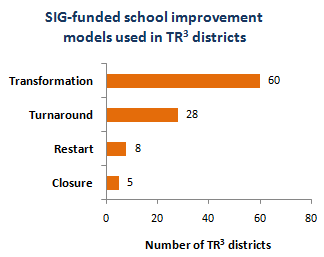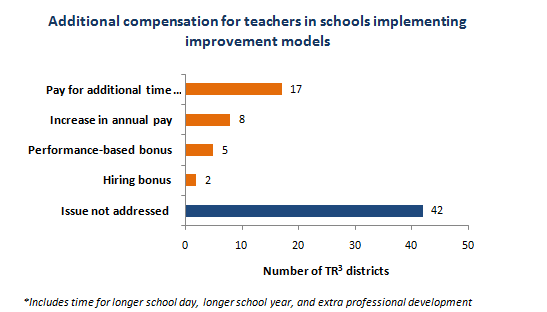Welcome to Tr3 Trends, NCTQ's monthly newsletter designed just for school district officials. Each month we use data from NCTQ's Tr3 database to highlight the latest trends in school district policies and collective bargaining agreements nationwide. Tr3 contains teacher policies from 113 school districts, including the 50 largest districts, the largest district in each state, Broad Prize winners, Gates investment districts, and members of the Council of the Great City Schools.
This month's issue looks at the strategies that Tr3 districts are pursuing to improve chronically poor-performing schools--using federal funds available through the School Improvement Grant (SIG), districts can implement the following improvement models:
- Turnaround: replace the principal and at least half the staff; revamp curricula, add professional development, and extend learning time, among other things
- Transformation: replace the principal; revamp curricula, add professional development, and extend learning time, among other things
- Restart: re-open a school as a charter or under an education management organization
- Close the school entirely.
Districts set policies specifically for these schools by negotiating them into teachers' contracts, using contract waivers, or creating rules for issues not covered in contracts. Here's what our data shows about the strategies being implemented:
Among TR3 districts using SIG funds, transformation is the most common school improvement model.

- 69 of Tr3's 113 districts received SIG money in 2010. Transformation was the most popular improvement model among these districts, with 60 of them implementing it in at least one under-performing school.
- The turnaround model was used in about half as many districts (28)
- 8 districts restarted schools, including Los Angeles, Chicago, and Philadelphia.
- Only five used SIG money to close underperforming schools: San Francisco, Milwaukee, Denver, Pittsburgh, and Oakland.
At least 39% of TR3 districts receiving SIG funds in 2010 allow schools using improvement models to extend the school day and/or year.
Philadelphia allows for the largest extension of the teacher day and year: one hour a day, along with up to two Saturdays a month and 22 days in July for additional teaching and in-service training. Fresno, Miami-Dade, and Guilford (NC) allow their schools to extend the year by ten days. Targeted Boston schools can add an hour to the teacher day, making it one of the longest daily extensions.
Milwaukee, Charlotte-Mecklenburg, and Prince George's County (MD) only state that their targeted schools need to figure out how to increase instructional time without extending the teacher work day or year.
Only 25% of TR3 districts receiving SIG funds in 2010 report directly providing teachers extra pay for working longer hours, though 22% report finding other ways to compensate teachers.

Pittsburgh has one of the most generous compensation packages, giving teachers in targeted schools $12,200 more each year than their peers in traditional schools. New York gives teachers 15% more than their normal salary (for up to two years).
Some districts provide a variety of supplemental pay for teachers who work in targeted schools. Boston automatically increases participating teachers' base salary by up to 5% and also provides additional compensation for working longer days and taking part in extra professional development. Similarly, in Oakland, teachers receive both additional compensation on a separate salary schedule and are paid for working longer hours than normal.
Go to Tr3's custom report page to access all the data we use in Tr3 Trends and to compare teacher policies in 113 school districts nationwide. Send feedback to gmoored@nctq.org.
